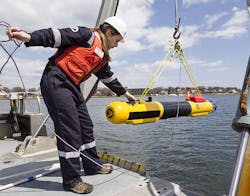General Dynamics boosts unmanned expertise in military UUV work with Bluefin Robotics acquisition
Bluefin Robotics will become part of the Maritime and Strategic Systems business line of General Dynamics Mission Systems in Fairfax, Va. The value of the transaction, announced this week, has not been disclosed.
General Dynamics and Bluefin Robotics have been collaborating on developing the Knifefish mine-hunting UUV for the U.S. Navy. The Knifefish UUV is a derivative of the Bluefin-21 UUV that can carry several sensors and payloads at once.
The Bluefin-21 made headlines in 2014 when it was chosen to scan the floor of the Indian Ocean in search of the missing Malaysia Airlines Flight 370.
The General Dynamics/Bluefin Knifefish UUV is a torpedo-shaped robot that measures 19 feet long, 21 inches in diameter, and weighs 1,700 pounds. Its power comes from a lithium-ion battery that enables the unmanned submersible to operate for as long as 16 hours on pre-programmed search missions.
The Knifefish has synthetic aperture sonar to detect floating or buried naval mines, and can identify mines with an onboard database and analytical computer.
story continues below
In operation, the Knifefish marks detected mines, records their locations, and uploads the data to its host surface ship, which most likely will be the Navy littoral combat ship (LCS). Each LCS with mine-hunting capability use two Knifefish UUVs to scan the sea bed near the ship.
"Bluefin’s advanced underwater technologies and products are perfectly aligned with our expertise in undersea system integration," says Chris Marzilli, president of General Dynamics Mission Systems.
Related: General Dynamics Knifefish UUV team eyes production after finishing critical design review
The combined companies could be expected to continue UUV development along the lines of the Bluefin-21, which offers swappable payload sections and battery modules for in-field mission reconfiguration. The UUV can be launched from a simple A-frame or docking head on several different kinds of surface ships.
The Bluefin-21 uses an inertial navigation system (INS) that helps confine the UUV's dead-reckoning drift to less than 0.1 percent of distance traveled, yielding higher quality data. The UUV also uses ultra-short baseline (USBL) underwater navigation.
For more information contact General Dynamics Mission Systems online at http://gdmissionsystems.com, or Bluefin Robotics at www.bluefinrobotics.com.
